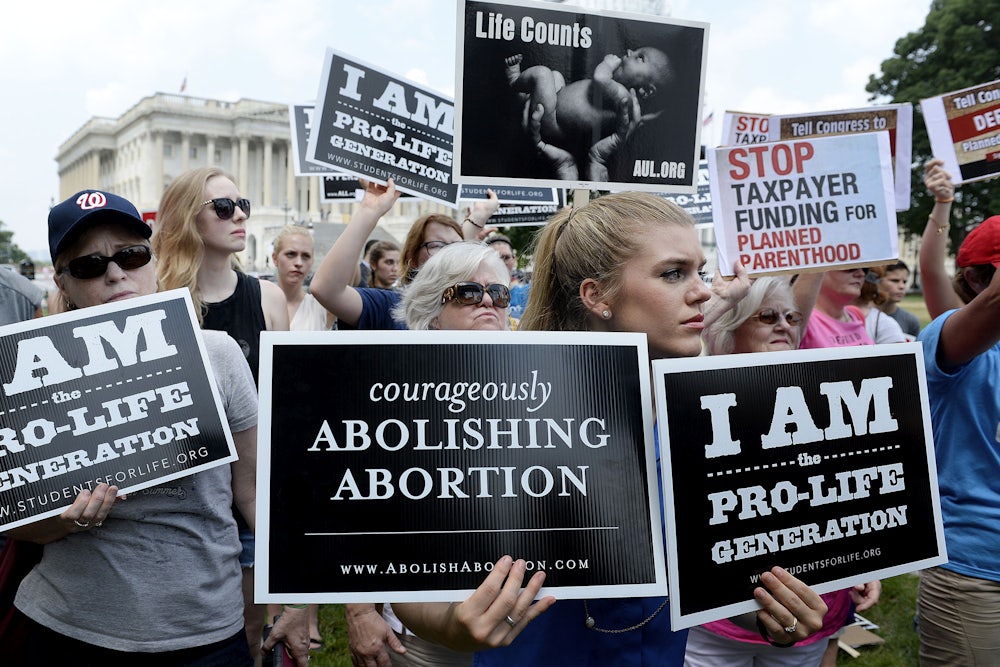Stacey Abrams still hasn’t conceded that she lost to Brian Kemp in last year’s gubernatorial race in Georgia, and perhaps justifiably so. Kemp, formerly the secretary of state there, administered his own election, shuttered precincts in black communities, and presided over a last-minute voting roll purge that targeted predominantly minority voters. Despite all that help, he eclipsed Abrams by fewer than 55,000 votes—another sign of how purple Georgia has become.
Last week, however, the state legislature enacted—and Kemp signed—one of the most extreme “fetal heartbeat” abortion prohibitions in the nation. HB 481, which declares that “unborn children are a class of living, distinct persons,” limits abortions to the first six weeks of pregnancy. If the law is allowed to take effect in January—rather than being held up in the courts—women who miscarry could be investigated by the state to determine whether their pregnancy ended unintentionally or with the help of a doctor or an abortion pill.
How does such a radical law get passed in such a politically competitive state? Gerrymandering has a lot to do with it. After the 2010 census, Republican mapmakers packed Democrats into as few districts as possible and used sophisticated voter data and computer mapping programs to entrench themselves in the others. As a result, Kemp won statewide with just 50.2 percent, but Republicans hold a 30-seat advantage in the state House and nearly a supermajority in the state Senate.
That ruthless partisan gerrymandering also turned Georgia’s legislative elections into some of the most uncompetitive in the nation. In 2016, 83 percent of state House races lacked a Republican or Democratic candidate. Those numbers improved modestly this past November, as Georgia’s high-profile race for governor propelled the highest midterm voter turnout there in modern history: 112 of the state’s 180 House districts—and 33 of the 56 state Senate contests—featured no major-party opponent.
We often think about gerrymandering as a wonky electoral problem that leads to oddly shaped districts resembling a praying mantis or Donald Duck kicking Goofy. But it has a major impact on people’s lives. Gerrymandering, in large part, created the conditions under which Michigan’s legislature could override the will of the voters and pass the emergency manager bill that led to the Flint water crisis. It also helps explain how the North Carolina legislature was able to use “surgical precision” to suppress the state’s black voters, and how proudly progressive Wisconsin assaulted collective bargaining and labor unions.
When a state is ruthlessly districted, voters are robbed of meaningful elections and, as just happened in Georgia, unrepresentative policies become law. For most districts in the state, the only elections that matter take place within party primaries—low-turnout elections in which extremists often prevail. When those legislators then enact the most draconian abortion policy in the nation, there’s almost nothing citizens can do to stop it.
This is how a minority hijacks politics. This is how Ohio, of all places, also just enacted a fetal-heartbeat abortion bill.
In 2018, Ohio voters split their votes for state representatives and senators nearly equally between Democrats and Republicans, with the GOP winning 50.3 percent statewide. But thanks to gerrymandering, 50 percent of the vote was enough to win them 63 percent of the seats. The maps were drawn to ensure big Republican majorities even in the most Democratic years: Despite the midterm’s “blue wave,” only six of 99 House seats were competitive enough to be within 5 percentage points.
Those legislators feel so emboldened and entrenched that last month they passed a bill that bans abortion as early as five weeks into a pregnancy, with no exceptions for rape or incest. Polling suggested that more Ohioans opposed the bill than supported it.
Americans have had it with this partisan assault on our elections. Last year, voters in Ohio, Michigan, Utah, Missouri, and Colorado passed ballot initiatives that would give citizens more power over the next round of redistricting, following the 2021 census. The courts may be fed up as well. Federal judges have overturned maps in Wisconsin, Maryland, North Carolina, Ohio, and Michigan; Pennsylvania’s state supreme court invalidated its congressional map.
The Maryland and North Carolina cases are now before the U.S. Supreme Court, where justices have long recognized partisan gerrymandering to be a problem but struggled to determine when a gerrymander crosses the line—and how involved the court should be in such a political process. But the lower courts, and many voters, have sent a clear message to the high court: Partisan gerrymandering is toxic to American democracy, and it’s within the justices’ ability to curb its worst excesses.
